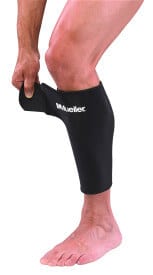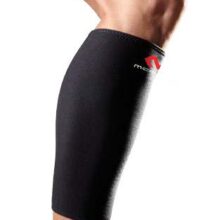Adjustable Calf/Shin Splint Support
Login For Health Care Pricing
Typically Ships in 1-2 weeks
The Mueller Sports Medicine Adjustable Calf/Shin Splint Support features a wraparound design for easy application and removal.

Calf sprains are a common injury that can occur during physical activities, sports, or everyday movements. They involve the stretching or tearing of the muscles or ligaments in the calf area.
This article aims to provide an overview of the causes, symptoms, and treatment options for calf sprains.
Calf sprains typically occur due to sudden movements, overexertion, or direct trauma to the calf muscles. Common causes include:
Rapid changes in speed or direction, such as during sports activities or sudden stops, can strain the calf muscles and lead to sprains.
Insufficient warm-up exercises before physical activity or exercise can increase the risk of calf sprains. Cold muscles are more prone to injury.
Overtraining or excessive physical activity without allowing sufficient time for rest and recovery can lead to muscle fatigue and increase the likelihood of sprains.
Wearing shoes that lack adequate support or do not fit properly can contribute to calf sprains. Inadequate footwear fails to provide stability and cushioning, placing excessive stress on the calf muscles.
Individuals who have experienced a previous calf sprain or have weak calf muscles may be more susceptible to future sprains.
The symptoms of a calf sprain can vary in severity but typically include:
Calf sprains are characterized by localized pain and tenderness in the calf muscle. The pain may be sudden and sharp or develop gradually.
Swelling and bruising around the injured area may occur due to inflammation and bleeding within the muscle fibers.
Calf sprains can make it challenging to walk or put weight on the affected leg. Severe sprains may cause significant difficulty in mobility.
Sprained calf muscles may feel weak and unstable, reducing the ability to push off or bear weight on the affected leg.
The injured calf may feel stiff, and there may be a noticeable decrease in the range of motion of the ankle and foot.
The initial treatment of a calf sprain aims to alleviate pain, reduce swelling, promote healing, and restore normal function. The following treatment options are commonly recommended:
Resting the injured leg and avoiding activities that worsen the pain is crucial for the initial healing phase. Immobilization using a brace, splint, or crutches may be necessary for severe sprains.
Applying ice packs or cold compresses to the affected area for 15-20 minutes every 2-3 hours can help reduce swelling and inflammation. Compression with an elastic bandage can provide support and minimize swelling.
Elevating the leg above the heart level can help reduce swelling by promoting proper blood flow.
Over-the-counter nonsteroidal anti-inflammatory drugs (NSAIDs) such as ibuprofen or acetaminophen can help manage pain and reduce inflammation.
Once the acute phase has passed, a physical therapist can guide rehabilitation exercises to restore strength, flexibility, and range of motion. They may use techniques like stretching, strengthening exercises, and manual therapy.
As healing progresses, a gradual return to normal activities and exercises is essential. This should be done under the guidance of a healthcare professional or physical therapist to prevent reinjury.
To reduce the risk of calf sprains, consider the following preventive measures:
Prior to engaging in physical activities or exercise, perform a proper warm-up routine that includes dynamic stretches to prepare the calf muscles.
Regularly incorporate exercises that strengthen the calf muscles and improve flexibility. Focus on exercises such as calf raises and stretches.
Wear appropriate footwear that provides adequate support, cushioning, and stability for the calf muscles.
As mentioned above, you should gradually increase the intensity and duration of physical activities or exercise to allow the calf muscles to adapt and reduce the risk of overuse injuries.
Pay attention to any signs of fatigue, pain, or discomfort in the calf muscles. Take breaks and rest when necessary.
Calf sprains can be painful and limit daily activities. Understanding the causes, recognizing the symptoms, and following appropriate treatment and preventive measures are crucial for recovery and minimizing the risk of future sprains.
If symptoms persist or worsen despite conservative measures, seeking medical attention is recommended for further evaluation and treatment.


Login For Health Care Pricing
Typically Ships in 1-2 weeks
The Mueller Sports Medicine Adjustable Calf/Shin Splint Support features a wraparound design for easy application and removal.

Login For Health Care Pricing
Out of Stock
The LP Support Calf Power Sleeve features a Y shaped Power Band, a Regulation Area and seamless Lycra for unmatched performance and comfort.

Login For Health Care Pricing
Typically Ships in 3-5 Business Days
The McDavid Calf Sleeve offers contoured, pull-on, latex-free thermal/compression therapy and soft tissue support.
Level 1: Primary Protection – Reducing pain associated with calf strains, shin splints and varicose veins; aids recovery

Login For Health Care Pricing
Out of Stock
Thanks to the SkinLok™ feature, a strategically positioned gel pad and its low profile design, the BioSkin Compression Shin Splint will provide you with unsurpassed relief from the pain of shin splits, calf strains and sprains and other injuries of the lower leg. Made in the USA.


Login For Health Care Pricing
Typically Ships in 1-2 weeks
The Incline Board is useful for stretching the upper and lower back as well as calf muscles in order to keep the tissues in these areas warm and supple.


Login For Health Care Pricing
Out of Stock
The LP EmbioZ Leg Support Tights with Silicone features a Power System along the lower body to improve muscle endurance, blood & lymphatic circulation and the overall efficiency of the lower body kinetic chain. Combined with its seamless design, general compression and Comfort System, these tights will take your performance to new levels while you enjoy greater comfort levels during training or competition.